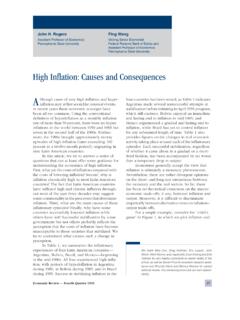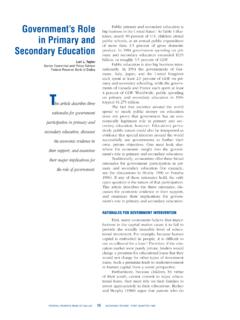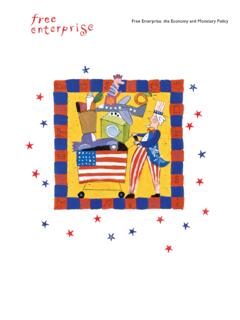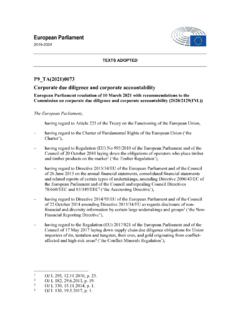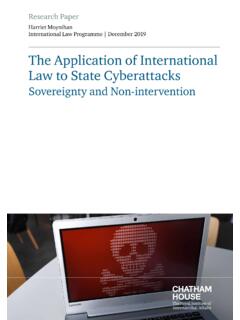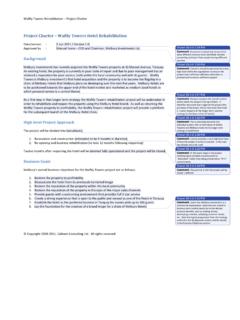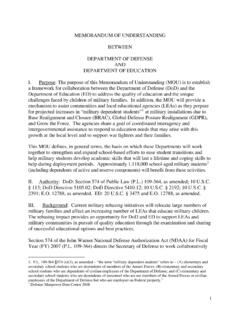Transcription of Hyperinflation in Zimbabwe - Dallas Fed
1 2 Federal reserve Bank oF Dallas Globalization and Monetary Policy Institute 2011 Annual Report One hundred trillion dollars that s 100,000,000,000,000 is the largest denomination of currency ever The Zimbabwean govern-ment issued the Z$100 trillion bill in early 2009, among the last in a series of ever higher denomina-tions distributed as inflation eroded purchasing power. When Zimbabwe attained independence in 1980, Z$2, Z$5, Z$10 and Z$20 denominations circulated, replaced three decades later by bills in the thousands and ultimately in the millions and trillions as the government sought to prop up a weakening economy amid spiraling inflation. Shortly after the Z$100 trillion note began circulating, the Zimbabwean dollar was officially abandoned in favor of foreign currencies. From 2007 to 2008, the local legal tender lost more than percent of its value (Hanke 2008).
2 This marked a reversal of fortune from independence, when the value of one Zimbabwe dollar equaled US$ Zimbabwe s extreme and uncontrollable inflation made it the first and so far only country in the 21st century to experience a Hyperinflation -ary episode. Hyperinflation devastates people and Hyperinflation in Zimbabwecountries. Zimbabwe , once considered the bread-basket of Africa, was reduced to the continent s beg-gar within a few years; its citizens were pushed into poverty and often forced to emigrate. The country s experience shows how a relatively self-sustaining nation at independence fell victim to out-of-control inflation and the severe erosion of wealth. The causes of Zimbabwe s Hyperinflation , its effects and how it was stopped are particularly instructive. In his seminal work, Phillip Cagan defined Hyperinflation as beginning when monthly inflation rates initially exceed 50 percent.
3 It ends in the month before the rate declines below 50 percent, where it must remain for at least a year (Cagan 1956). Zim-babwe entered the hyperinflationary era in March 2007; the period ended when the nation abandoned its currency in 2009 (Chart 1). The evolution of the Zimbabwean dollar in the post-independence period is shown in the timeline on page 10. Bouts of Hyperinflation are mostly accompa-nied by rapidly increasing money supply needed to finance large fiscal deficits arising from war, revolution, the end of empires and the establish-ment of new states. Hyperinflation , as Cagan defined it, initially appeared during the French Revolution, when the monthly rate peaked at 143 percent in December 1795. More than a century elapsed before Hyperinflation appeared again. During the 20th century, Hyperinflation occurred 28 times, often associated with the monetary chaos involving two world wars and the collapse of communism (Bernholz 2003).
4 Zimbabwe s hy-perinflation of 2007 09 represents the world s 30th occurrence as well as the continent s second bout (after a 1991 94 episode in the Congo).2 Zimbabwe s History Zimbabwe is located in the southern region of The historic Zimbabwean $100 trillion bill is now a novelty and Monetary Policy Institute 2011 Annual Report Federal reserve Bank oF Dallas 3the African continent and is bounded to the north by Zambia, to the east by Mozambique, to the south by South Africa and to the west by Botswana and the Caprivi Strip of Namibia. At 390,757 square kilometers (150,871 square miles), Zimbabwe is about the size of California, with a population the United Nations estimated at million in 2011. Its capital is Harare. The nation s name is derived from historical structures called Great Zimbabwe (houses of stone), the largest stone sculptures in Africa after the pyramids of country was settled by the British in 1890, when Cecil Rhodes, a businessman who made his fortune mining diamonds in South Africa, pushed northward in search of more bounty.
5 Rhodes successfully persuaded the British to grant a royal charter to his British South Africa Co., which he used to promote the colonization of the region. The country was renamed Southern Rhodesia in 1895 in his honor. It became a self-governing British colony in October 1923, following a 1922 referendum. In 1953, in the face of African op-position, Britain consolidated the colonies of Rhodesia (Northern and Southern Rhodesia) with Nyasaland into the Federation of Rhodesia and Nyasaland. Growing African nationalism and dis-sent, particularly in Nyasaland, persuaded Britain to dissolve the union in 1963 and form three colonies Northern Rhodesia, Southern Rhodesia and much of the colonial period, from 1890 to 1979, blacks and whites fought over land and political involvement, as the local population resisted marginalization. Several uprisings were mostly quickly ended, the leaders imprisoned.
6 Two political parties that formed in the 1960s proved resilient the Zimbabwe African National Union (ZANU) under Robert Mugabe and the Zimbabwe African Peoples Union (ZAPU) under Joshua the early 1960s, as colonial rule ended throughout the continent and as African-majority governments assumed control in neighboring Northern Rhodesia (now Zambia) and Nyasa-land (now Malawi), the white-minority Southern Rhodesia government led by Ian Smith issued a Unilateral Declaration of Independence from the United Kingdom on Nov. 11, 1965. The move scuttled Britain s plan for a multiracial democracy, prompting sanctions from the former colonial power, which deemed the independence declara-tion illegal. Still, the white-minority government claimed nation status as the Republic of Rhodesia, or simply Rhodesia, in civil war ensued, with African guerrilla groups under ZAPU and ZANU leadership taking Chart 1 Zimbabwe Consumer Price Inflation Soars Amid Hyperinflationary PeriodPercent, month/month 50050100150200250300350400450500 07 04 01 98 95 92 89 86 83 80 July 2008,inflation at 2, percentMarch 2007,inflation exceeds50 percentPercent, month/monthConsumer Prices Stabilize in 2009 10 4 3 2 1012201120102009 SOURCES: International Monetary Fund s International Financial Statistics database; Reserve Bank of Zimbabwe s Monthly Economic Reviews.
7 4 Federal reserve Bank oF Dallas Globalization and Monetary Policy Institute 2011 Annual Reportup arms from bases in Zambia and Mozambique. In 1979, an agreement on a new constitution, transitional arrangements and a ceasefire were reached at a conference convened in Lancaster House in London. Following elections the next February, Mugabe became the first prime minister and formed a coalition government that included former ZAPU leader Nkomo. Zimbabwe became a recognized independent nation on April 18, 1980. The Mugabe government has ruled ever and During HyperinflationTo trace the economy s deterioration and un-derstand the causes of the extreme price changes, it helps to compare 1980 (when newly indepen-dent Zimbabwe left behind its identity as Rhode-sia) with 2008 09, the height of Hyperinflation . At independence, annual inflation was percent; month-to-month inflation averaged percent.
8 The largest currency denomination was Z$20, and the Zimbabwean dollar was the most widely used currency involved in more than 95 percent of transactions. Officially, US$1 bought Z$ , and real GDP in 1980 grew percent over 1979 levels (Chart 2). On a per capita basis, real GDP (purchasing-power-parity adjusted) in 2005 prices equaled US$232; the unemployment rate was percent in 1982. By July 2008, when Zimbabwe s Central Sta-tistical Office released its last inflation figures for that year, the month-over-month (nonannualized) rate had reached 2, percent more than 231 million percent on a year-over-year basis. The In-ternational Monetary Fund (IMF) put the annual inflation rate in September 2008 at 489 billion per-cent, with some independent analysts estimating it much The largest currency denomination in 2009 was the Z$100 trillion note.
9 However, the most widely used currencies in almost all transac-tions were the dollar, South African rand and the Botswana pula. At the official exchange rate on Dec. 31, 2008, US$1 traded for Z$4 million, although parallel black-market rates were much greater. In 2008, real GDP contracted 17 percent (Chart 2), with per capita GDP at US$136 41 percent below what it was at independence. The unemployment rate stood at 94 percent, according to a report by the Office for the Coordination of Humanitarian Affairs, and the country became the bread beggar of Africa (Makochekanwa 2009).5 Zimbabwe s Inflation NightmareZimbabwe s economic crisis and subsequent Hyperinflation were preceded by several years of economic decline and mounting public debt. Weakening began in 1999, coinciding with periods of drought that adversely affected the agriculturally dependent nation.
10 External debt as a share of GDP increased to 119 percent in 2008 from 11 percent in 1980. Land reallocation in 2000 and 2001, which redistributed large agricultural tracts, depressed commercial farming output. Output fell 50 percent between 2000 and 2009, led by a decline in the country s major foreign-exchange cash crop, tobacco, which slid 64 percent in 2008 from 2000 levels (Chart 3). Commercial production of maize, Signs such as this one appeared in Zimbabwe during its Hyperinflation credit: Eugene BaronGlobalization and Monetary Policy Institute 2011 Annual Report Federal reserve Bank oF Dallas 5the national staple, dropped 76 percent during the same time (FAOSTAT Database 2011).Uncontrolled government spending accom-panied the weak economy. In 1997, authorities approved unbudgeted expenditures, amounting to almost 3 percent of GDP, for bonuses to approxi-mately 60,000 independence war veterans.

